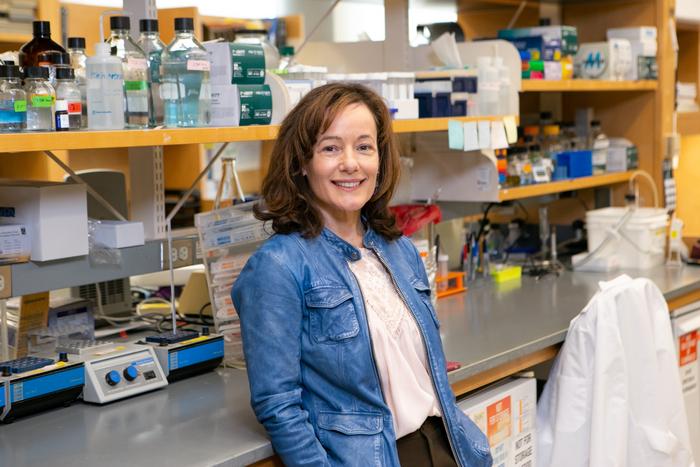
Recent groundbreaking research conducted by scientists at UMass Chan Medical School has yielded promising insights into the mechanisms underlying the efficacy of cancer-fighting drugs, particularly in relation to BRCA1 and BRCA2 tumor cells. The collaborative efforts of Dr. Sharon Cantor and Dr. Jenna M. Whalen have challenged existing paradigms concerning how certain anticancer agents operate, particularly poly (ADP-ribose) polymerase inhibitors (PARPi), which are known for their targeted approach against BRCA-deficient cancers. Their findings, published in the esteemed journal Nature Cancer, illuminate a critical vulnerability in cancer cells that could lead to new therapeutic strategies.
The study reveals that cancer cells harboring mutations in BRCA1 or BRCA2 genes, integral to the body’s response to DNA damage, demonstrate heightened sensitivity to specific types of DNA damage. The conventional wisdom surrounding the action of PARP inhibitors was primarily focused on the idea that single-stranded DNA breaks, induced by these drugs, would ultimately lead to double-stranded breaks and subsequent cellular death. However, this research indicates a more complex interaction, wherein single-stranded DNA nicks can expand and form larger gaps that are lethal to mutated BRCA1 and BRCA2 cancer cells.
Mutations in BRCA genes substantially elevate the risk of developing certain cancers, with breast and ovarian cancers being notably prevalent among affected individuals. The paradox of BRCA mutations lies in their dual role as tumor suppressors and as facilitators of vulnerability to specific anticancer therapies. This relationship is critical; drugs that hinge on the presence of BRCA mutations can induce lethal DNA damage that these cancer cells struggle to repair. Thus, understanding the underlying mechanisms of sensitivity remains paramount in optimizing treatment protocols for cancer patients.
Utilizing cutting-edge CRISPR technology, Dr. Cantor and Dr. Whalen undertook a meticulous approach to elucidate how BRCA-deficient cells respond to controlled induction of single-stranded breaks in DNA. The research methodology involved specifically engineered CRISPR systems to create DNA nicks in various breast cancer cell lines, allowing the scientists to observe the cellular responses in real-time. Surprisingly, they discovered that the BRCA-deficient cells exhibited a unique sensitivity to these single-stranded nicks. This discovery further emphasizes the need to reassess the dynamics of DNA damage repair pathways in BRCA-mutated cancer cells.
Additionally, the research team investigated how further modifications in the DNA repair machinery affect cellular responses to these nicks. They found that certain breast cancer cells that lose key protective components against DNA damage become increasingly resistant to traditional chemotherapy treatments, including PARP inhibitors. This paradigm shift showcases an intricate dance of cellular repair mechanisms, revealing that the survival of BRCA-deficient cells does not solely rely on restoring double-strand DNA repair functions. Instead, these cells showed heightened sensitivity to the accumulation of single-stranded nicks that eventually resulted in larger, catastrophic gaps within their DNA.
In a significant revelation, Dr. Whalen articulated, “Our findings reveal that it is the resection of a nick into a single-stranded DNA gap that drives cellular lethality.” This statement encapsulates the essence of their findings: it is not merely the presence of DNA damage that leads to cell death, but rather the erroneous repair and accumulation of damage that turns these cells into a target for therapeutic interventions.
The study concludes with a compelling proposition regarding the therapeutic implications of their findings. The research suggests that PARP inhibitors may function not just by inducing double-stranded DNA breaks but actively create nicks that exploit the compromised repair mechanisms in BRCA1 and BRCA2 deficient cells. This offers a critical perspective, especially for cancers that have exhibited resistance to PARP inhibitors. By targeting these nicks, new treatment modalities could be developed to selectively exploit these persistent vulnerabilities, thereby overcoming drugs’ limitations in resistant cancer phenotypes.
Taking the findings further, Dr. Cantor noted the implications of inducing nicks through strategies like ionizing radiation for treating PARP inhibitor-resistant cells. This highlights a potential new frontier in cancer treatment, where specific targeting of DNA nicks could pave the way for innovative therapeutic strategies that not only circumvent resistance mechanisms but also enhance the overall efficacy of existing cancer treatments.
By leveraging these insights, the scientific community aims to develop more precise and effective targeted therapies, which could transform the landscape of treatment options for patients with BRCA-mutated cancers. Further exploration of DNA damage mechanisms offers hope for a future where the intricacies of genetic vulnerabilities can be exploited to develop novel, life-saving interventions, ultimately leading to improved patient outcomes.
In conclusion, the revolutionary findings by Dr. Cantor and Dr. Whalen stand as a testament to the power of innovative research in oncology. By redefining our understanding of DNA damage and repair relationships in BRCA-deficient cancer cells, their work opens up new avenues for therapeutic exploration. As scientists strive to unravel the complexities of cancer, these revelations could very well contribute to a critical shift in how we approach cancer treatment, fostering a future where personalized medicine based on genetic vulnerabilities becomes the norm.
This research underscores the importance of continuous investigation in the realm of cancer treatment. As we enhance our understanding of the molecular intricacies of cancer cells, we pave the way for groundbreaking therapies that are informed by the very mechanisms that govern cancer survival and resistance. The journey to conquer cancer is undoubtedly arduous, but with each discovery, we move closer toward innovative interventions that may one day lead to a definitive cure.
Subject of Research: Animals
Article Title: Targeting BRCA1-deficient PARP inhibitor-resistant cells with nickases reveals nick resection as a cancer vulnerability
News Publication Date: 21-Jan-2025
Web References:
References:
Image Credits: Photo: UMass Chan Medical School
Keywords: Breast cancer, Single stranded DNA, Genomic DNA, DNA strands, Chemotherapy, DNA damage, Drug resistance, Breast cancer cells, Cancer research, DNA repair, Homologous recombination.
Tags: anticancer drug mechanismsBRCA1 and BRCA2 mutationsbreast and ovarian cancer researchcancer cell vulnerabilitiesDNA damage responsedouble-stranded DNA breaksNature Cancer journal findingsPARP inhibitorssingle-stranded DNA breakstargeted cancer therapiestherapeutic strategies for BRCA mutationsUMass Chan Medical School





